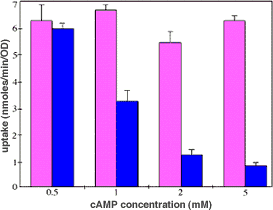Thesis Research
* Senior Project in Biochemistry
Michaela Pfieffer '96
"cAMP concentrations influence amino acid uptake in Saccharomyces cerevisiae."
Abstract
Studies of the growth of Saccharomyces cerevisiae show that adenosine 3',5' - cyclic monophosphate (cAMP) plays an important role in the shift from fermentive to oxidative metabolism (the diauxic shift). It has been suggested that the RAS/cAMP pathway monitors nutrient availability and provides a signal to the yeast cell whether to continue into other stages in the cell cycle. Ras is known to signal glucose availability exhibiting a sharp rise in cAMP production upon the addition of glucose to glucose starved cells. This change in adenylate cyclase activity has not been observed in similar experiments performed with nitrogen as the limiting nutrient. Thevelein (1992) proposed a model for nitrogen signaling in Saccharomyces cerevisiae whereby an alternate pathway communicates with the Ras pathway at the level of cAMP-targeted protein kinases. The objective of this study was to determine if cAMP could signal nitrogen availability by influencing amino acid transport into the yeast cell. To quantitate amino acid uptake, we measured the activity of the specific high affinity permease, general amino acid permease (Gap1). Gap1 has the capacity to transport almost all amino acids including cirtrulline. Gap1 activity was measured as a function of C14-citrulline uptake by the cells. The strain used in these experiments had a mutation in the cyr1- locus rendering it unable to synthesize cAMP, and had a cam mutation which made the cell membrane permeable to cAMP. Cells were grown up in a media containing varied concentrations of cAMP, and were assayed for C14-citrulline uptake at points during exponential growth. We found that there was a distinct trend in amino acid uptake which decreased as cAMP concentrations were increased. This result suggested that some region in the RAS/cAMP pathway, upstream of protein kinase A, was sensitive to nitrogen availability. By actively influencing the production of cAMP, this region in the pathway effectively regulated the amount of amino acids taken in by the yeast cell.
The effects of cAMP concentration on amino acid
uptake in Saccharomyces cerevisiae:




